Country
Crash of a Cessna 421A Golden Eagle I in DeLand: 3 killed
Date & Time:
Sep 29, 2019 at 1600 LT
Registration:
N731PF
Survivors:
No
Schedule:
DeLand - DeLand
MSN:
421A-0164
YOM:
1968
Crew on board:
1
Crew fatalities:
Pax on board:
2
Pax fatalities:
Other fatalities:
Total fatalities:
3
Captain / Total hours on type:
0.00
Aircraft flight hours:
858
Circumstances:
The owner of the airplane had purchased the airplane with the intent to resell it after repairs had been made. As part of that process, a mechanic hired by the owner had assessed the airplane’s condition, proposed the necessary repairs to the airplane’s owner, and had identified a pilot who would, once the repairs and required inspection annual inspection had been completed, fly the airplane from where it was located to where the owner resided. While the mechanic had identified a potential pilot for the relocation flight, he had not yet completed the repairs to the airplane, nor had he completed the necessary logbook entries that would have returned the airplane to service. The pilot-rated passenger onboard the airplane for the accident flight, was the pilot who had been identified by the mechanic for the relocation flight. Review of the pilot-rated passenger’s flight experience revealed that he did not possess the necessary pilot certificate rating, nor did he have the flight experience necessary to act as pilot-in-command of the complex, highperformance, pressurized, multi-engine airplane. Additionally, the owner of the airplane had not given the pilot-rated-passenger, or anyone else, permission to fly the airplane. The reason for, and the circumstances under which the pilot-rated passenger and the commercial pilot (who did hold a multi-engine rating) were flying the airplane on the accident flight could not be definitively determined, although because another passenger was onboard the airplane, it is most likely that the accident flight was personal in nature. Given the commercial pilot’s previous flight experience, it is also likely that he was acting as pilot-in-command for the flight. One witness said that he heard the airplane’s engines backfiring as it flew overhead, while another witness located about 1 mile from the accident site heard the accident airplane flying overhead. The second witness said that both engines were running, but they seemed to be running at idle and that the flaps and landing gear were retracted. The witness saw the airplane roll to the left three times before descending below the tree line. As the airplane descended toward the ground, the witness heard the engines make “two pop” sounds. The airplane impacted a wooded area about 4 miles from the departure airport, and the wreckage path through the trees was only about 75-feet long. While the witnesses described the airplane’s engines backfiring or popping before the accident, the postaccident examination of the wreckage revealed no evidence of any preimpact mechanical malfunctions or failures that would have precluded normal operation. Additionally, examination of both propeller blades showed evidence of low rotational energy at impact, and that neither propeller had been feathered in flight. Given the witness statement describing the airplane “rolling three times” before it descended from view toward the ground, it is most likely that the pilot lost control of the airplane and while maneuvering. It is also likely that the pilot’s lack of any documented previous training or flight experience in the accident airplane make and model contributed to his inability to maintain control of the airplane. Toxicology testing was performed on the pilot’s chest cavity blood. The results identified 6.7 ng/ml of delta-9-tetrahydracannabinol (THC, the active compound in marijuana) as well as 2.6 ng/ml of its active metabolite, 11-hydroxy-THC and 41.3 ng/ml of its inactive metabolite delta9-carboxy-THC. Because the measured THC levels were from cavity blood, it was not possible to determine when the pilot last used marijuana or whether he was impaired by it at the time of the flight. As a result, it could not be determined whether effects from the pilot’s use of marijuana contributed to the accident circumstances.
Probable cause:
The pilot’s failure to maintain control of the airplane, which resulted in a collision with terrain. Contributing was the pilot’s lack of training and experience in the accident airplane make and model.
Final Report:




Crash of a Cessna 421A Golden Eagle I near Buenos Aires
Date & Time:
May 31, 2017 at 1740 LT
Registration:
LQ-JLY
Survivors:
Yes
Schedule:
El Palomar - Buenos Aires
MSN:
421A-0092
YOM:
1968
Crew on board:
2
Crew fatalities:
Pax on board:
1
Pax fatalities:
Other fatalities:
Total fatalities:
0
Captain / Total hours on type:
50.00
Copilot / Total hours on type:
320
Aircraft flight hours:
5826
Circumstances:
The twin engine airplane departed El Palomar Airport at 1604LT on a training flight, carrying one passenger and two pilots. While descending to Buenos Aires-Ezeiza-Ministro Pistarini Airport, the right engine failed. The crew was unable to restart the engine and to maintain a safe altitude, so he attempted an emergency landing when the aircraft crashed in an open field located 24 km from the airport, bursting into flames. All three occupants were injured and the aircraft was partially destroyed by fire.
Probable cause:
Failure of the right engine in flight due to fuel exhaustion. Lack of proper procedures by the operator was considerd as a contributing factor.
Final Report:
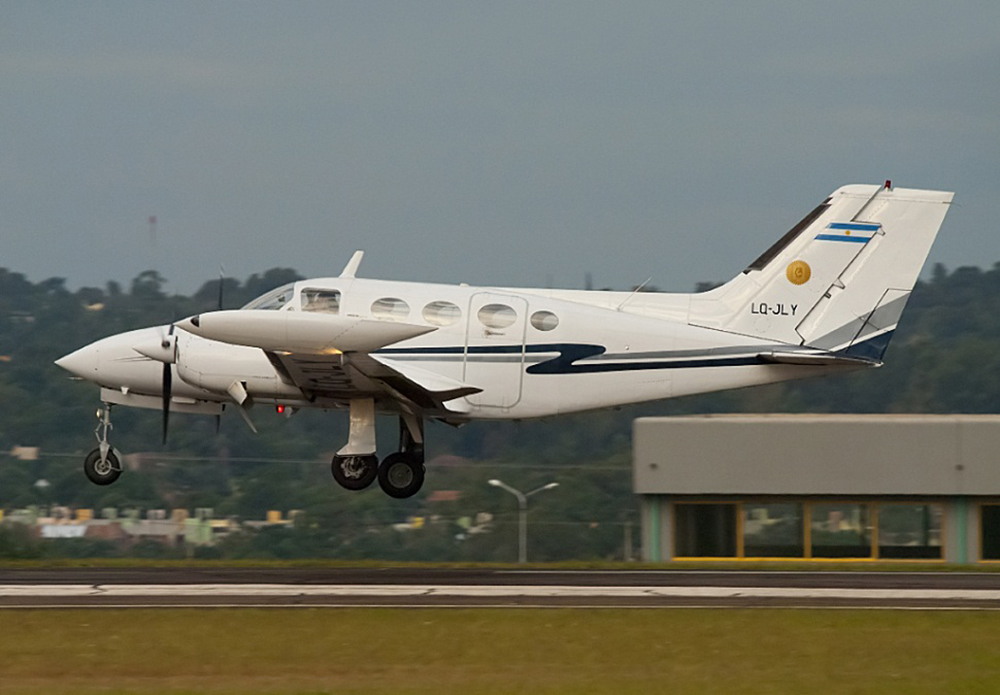

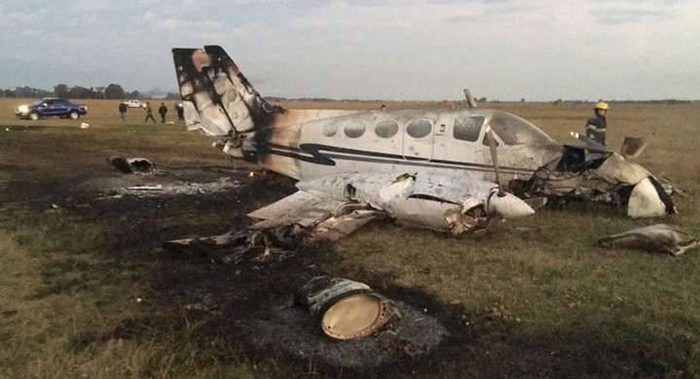
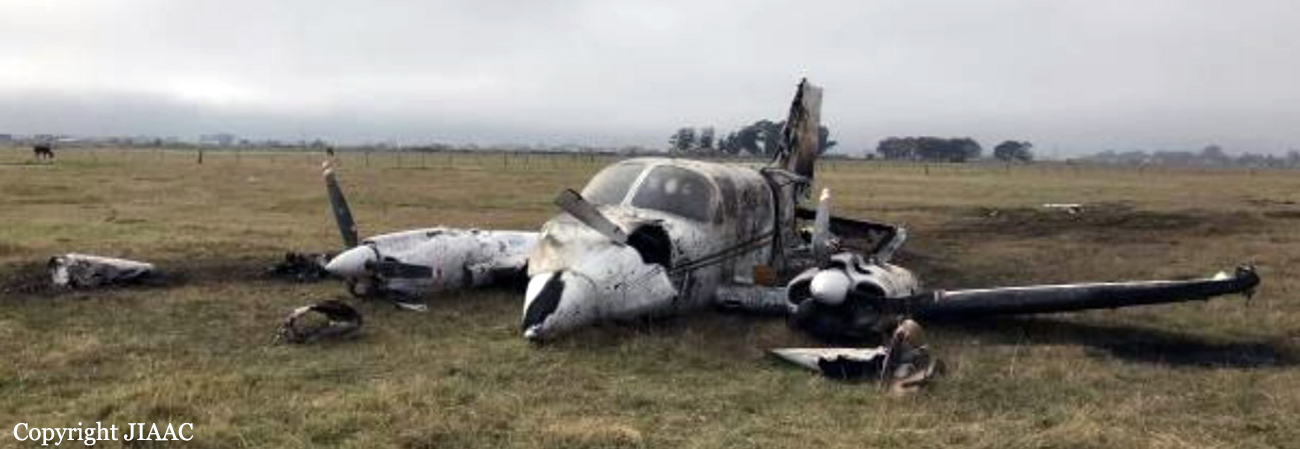
Crash of a Cessna 421A Golden Eagle I in Monterrey
Date & Time:
May 21, 2015
Registration:
XB-MTC
Survivors:
Yes
Schedule:
Monterrey – Piedras Negras
Crew on board:
1
Crew fatalities:
Pax on board:
4
Pax fatalities:
Other fatalities:
Total fatalities:
0
Circumstances:
Shortly after take off from Monterrey-Del Norte Airport, while climbing, the pilot encountered unknown technical problems and attempted an emergency landing in the Seventh Military Zone of the Secretary of the National Defense located west of the airport. The aircraft crashed in a pasture and came to rest upside down, bursting into flames. All five occupants were quickly rescued by military personal while the aircraft was partially destroyed by fire.


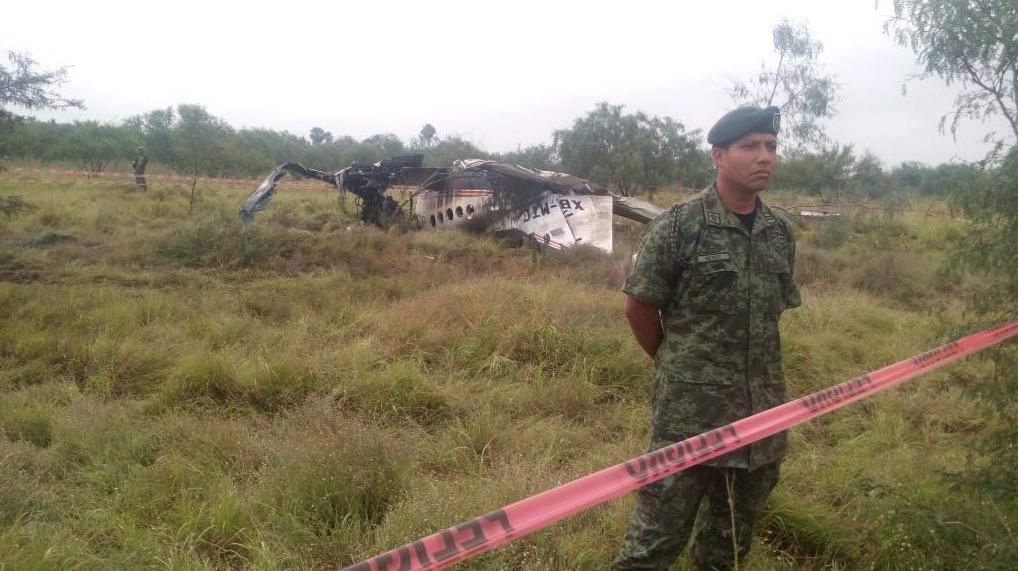


Crash of a Cessna 421A Golden Eagle I at Annino AFB: 2 killed
Date & Time:
Aug 22, 2012 at 1517 LT
Registration:
RA-0879G
Survivors:
No
Schedule:
Annino - Annino
MSN:
421A-0075
YOM:
1968
Crew on board:
2
Crew fatalities:
Pax on board:
0
Pax fatalities:
Other fatalities:
Total fatalities:
2
Circumstances:
In the afternoon, the crew departed Annino AFB (Gorelovo) to complete a local training mission consisting of touch-and-go maneuvers. After two circuits, the aircraft landed normally and the crew took off and started the rotation without informing ATC. After liftoff, at a height of about 10-15 metres, the aircraft rolled to the right to an angle of 70° then stalled and crashed in a kindergarten located one km from the airport, bursting into flames. The aircraft was destroyed and both pilots were killed.
Probable cause:
Most probably the accident with С-421 (FVSP) RA-0879G aircraft was caused by right and then left engine flameout during touch-and-go landing, flight speed decrease and aircraft stall entry resulted in aircraft ground impact with bank angle over 70°. Most probably engines flameout midair was caused by fuel-air mixture depletion due to low level of fuel in aircraft tanks that in combination with its inadequate quality resulted in engines trouble.
Combination of the following factors could contribute to the accident:
- Flight operation with low level of fuel on board.
- Inadequate fuel quality.
- Inadequate crew training for forthcoming flight.
- Inadequate maintenance prior to aircraft familiarization flight after its long-term parking.
- Touch-and-go landing and continued takeoff with engines trouble during run operation.
- Non-feathering of switched-off engine propeller midair (non compliance with requirement of clause "2" of subsection 3 of «ENGINE INOPERATIVE PROCEDURE» section aircraft FOM).
- Possible on position failure of fuel booster pump switches by crew before aircraft take-off.
- Inadequate flight operation management, aircraft maintenance and efficiency discipline in "Aviator" Airclub" LLC, weak monitoring from senior staff over maintenance operation on accident prevention.
- The flight was performed by crew on aircraft without airworthiness certificate (violation of clause 1 article 35 of Air Code of RF and clause 1 of FAR-118).
Combination of the following factors could contribute to the accident:
- Flight operation with low level of fuel on board.
- Inadequate fuel quality.
- Inadequate crew training for forthcoming flight.
- Inadequate maintenance prior to aircraft familiarization flight after its long-term parking.
- Touch-and-go landing and continued takeoff with engines trouble during run operation.
- Non-feathering of switched-off engine propeller midair (non compliance with requirement of clause "2" of subsection 3 of «ENGINE INOPERATIVE PROCEDURE» section aircraft FOM).
- Possible on position failure of fuel booster pump switches by crew before aircraft take-off.
- Inadequate flight operation management, aircraft maintenance and efficiency discipline in "Aviator" Airclub" LLC, weak monitoring from senior staff over maintenance operation on accident prevention.
- The flight was performed by crew on aircraft without airworthiness certificate (violation of clause 1 article 35 of Air Code of RF and clause 1 of FAR-118).


Crash of a Cessna 421A Golden I Eagle in Tulsa: 3 killed
Date & Time:
Jul 10, 2010 at 2205 LT
Registration:
N88DF
Survivors:
No
Schedule:
Pontiac – Tulsa
MSN:
421A-0084
YOM:
1968
Crew on board:
1
Crew fatalities:
Pax on board:
2
Pax fatalities:
Other fatalities:
Total fatalities:
3
Captain / Total hours on type:
67.00
Aircraft flight hours:
640
Circumstances:
During the 3.5-hour flight preceding the accident flight, the airplane used about 156 gallons of the 196 gallons of usable fuel. After landing, the airplane was topped off with 156 gallons of fuel for the return flight. During the preflight inspection, a line serviceman at the fixed based operator observed the right main fuel tank sump become stuck in the open position. He estimated 5 to 6 gallons of fuel were lost before the sump seal was regained, but the exact amount of fuel lost could not be determined. The lost fuel was not replaced before the airplane departed. Data from an on board GPS unit indicate that the airplane flew the return leg at an altitude of about 4,500 feet mean sea level for about 4 hours. About 4 minutes after beginning the descent to the destination airport, the pilot requested to divert to a closer airport. The pilot was cleared for an approach to runway 18R at the new destination. While on approach to land, the pilot reported to the air traffic control tower controller, “we exhausted fuel.” The airplane descended and crashed into a forested area about 1/2 mile from the airport. Post accident examination of the right and left propellers noted no leading edge impact damage or signatures indicative of rotation at the time of impact. Examination of the airplane wreckage and engines found no malfunctions or failures that would have precluded normal operation. The pilot did not report any problems with the airplane or its fuel state before announcing the fuel was exhausted. His acceptance of the approach to runway 18R resulted in the airplane flying at least 1 mile further than if he had requested to land on runway 18L instead. If the pilot had declared an emergency and made an immediate approach to the closest runway when he realized the exhausted fuel state, he likely would have reached the airport. Toxicological testing revealed cyclobenzaprine and diphenhydramine in the pilot’s system at or above therapeutic levels. Both medications carry warnings that use may impair mental and/or physical abilities required for activities such as driving or operating heavy machinery. The airplane would have used about 186 gallons of fuel on the 4-hour return flight if the engines burned fuel at the same rate as the previous flight. The fuel lost during the preflight inspection and the additional 30 minutes of flight time on the return leg reduced the airplane’s usable fuel available to complete the planned flight, and the pilot likely did not recognize the low fuel state before the fuel was exhausted due to impairment by the medications he was taking.
Probable cause:
The pilot’s inadequate preflight fuel planning and management in-flight, which resulted in total loss of engine power due to fuel exhaustion. Contributing to the accident was the pilot’s use of performance-impairing medications.
Final Report:



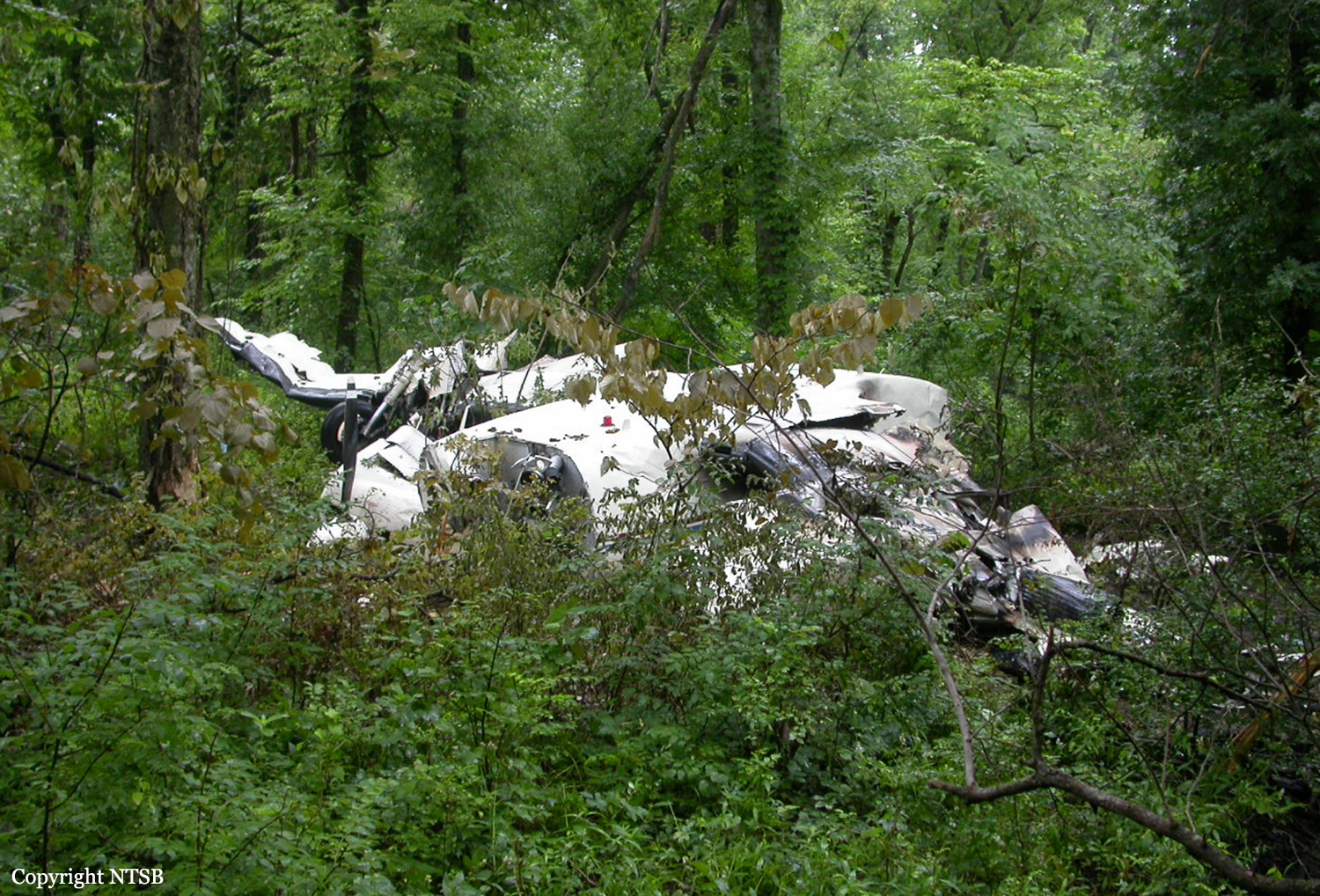
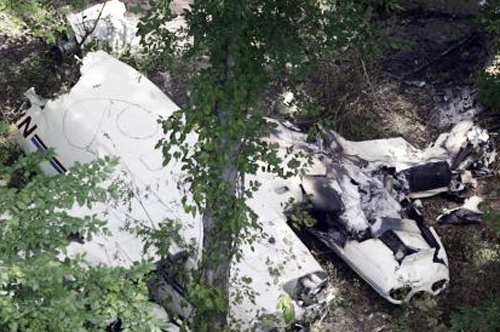
Crash of a Cessna 421A Golden Eagle I in Saltillo
Date & Time:
Apr 25, 2008 at 1200 LT
Registration:
XB-WUF
Survivors:
Yes
Schedule:
Saltillo – Aguascalientes
MSN:
421A-0124
YOM:
1968
Crew on board:
1
Crew fatalities:
Pax on board:
5
Pax fatalities:
Other fatalities:
Total fatalities:
0
Circumstances:
Shortly after takeoff from Saltillo-Plan de Guadalupe Airport, while in initial climb, one of the engine caught fire. The pilot attempted an emergency landing when the aircraft crash landed in a field past the runway end, bursting into flames. All six occupants escaped with minor injuries and the aircraft was destroyed.
Probable cause:
Engine fire for unknown reasons.
Crash of a Cessna 421A Golden Eagle I in Chesterfield
Date & Time:
May 23, 2007 at 1540 LT
Registration:
N4082L
Survivors:
Yes
Schedule:
Chesterfield - Cahokia
MSN:
421A-0082
YOM:
1968
Crew on board:
1
Crew fatalities:
Pax on board:
0
Pax fatalities:
Other fatalities:
Total fatalities:
0
Captain / Total hours on type:
1200.00
Aircraft flight hours:
2835
Circumstances:
Shortly after takeoff the pilot experienced a loss of power on the right engine. He attempted to return to the airport to land, but determined that he was not going to reach the runway so he elected to land on a dirt field. He flew under power lines that were in his flight path and attempted to flare the airplane prior to it impacting the terrain. The airplane was equipped with Teledyne Continental GTSIO-520 engines. Post accident examination of the right engine revealed that all of the teeth on the starter adapter gear and several of the teeth on the crankshaft gear were missing. Several gear teeth and metal filings were located in the oil sump. The torsional damper to shaft gear woodruff key was sheared. The torsional damper was placed on a test bench to determine the damping time. The consecutive tests averaged a damping time of 6.9 seconds. The damping time of a new damper is min/max 1.5 to 3.125 seconds. Metallurgical examination revealed 15 starter gear teeth and 11 crankshaft gear teeth were fractured near their root. No indications of preexisting cracking were noted. At least two of the starter gear teeth and several of the crankshaft gear teeth displayed spalling and wear at the pitch line of the teeth. On June 13, 1994, Teledyne Continental issued a Mandatory Service Bulletin, MSB94-4, addressing the possible failure of the starter adapter gear and/or crankshaft gear on GTSIO-520 and GIO-550 engines. On October 31, 2005, Teledyne Continental issued revision, MSB94-4G. The service bulletin called for an inspection of the starter adapter viscous damper and shaft gear backlash every 100 hours of engine operation, and a visual inspection of the starter adapter shaft and crankshaft gear teeth for spalling, pitting, and wear, every 400 hours of engine operation. The Federal Aviation Administration (FAA) issued Airworthiness Directive (AD) 2005-20-04, effective November 1, 2005, requiring compliance with the Teledyne Continental Mandatory Service Bulletin. Maintenance records showed the mandatory service bulletin had been complied with when the right engine was overhauled and installed in March 2001. There was no indication in the maintenance records that either the mandatory service bulletin or the AD had been complied with since the engine was installed. The engine had a total time of 541.9 hours at the time of the accident. The pilot did not follow the published emergency procedures.
Probable cause:
Maintenance personnel failed to comply with an Airworthiness Directive which resulted in the total failure of the starter adapter gear teeth and the crankshaft gear teeth and the pilot failed to follow the published emergency procedures. Contributing to the accident were the low altitude at which the loss of power occurred, the power lines, and the unsuitable terrain which prevented the pilot from adequately flaring the airplane and resulted in the subsequent hard landing.
Final Report:
Crash of a Cessna 421A Golden Eagle I in Denver: 3 killed
Date & Time:
Dec 17, 2004 at 1522 LT
Registration:
N421FR
Survivors:
No
Schedule:
Denver - Denver
MSN:
421A-0069
YOM:
1968
Crew on board:
3
Crew fatalities:
Pax on board:
0
Pax fatalities:
Other fatalities:
Total fatalities:
3
Copilot / Total hours on type:
31
Aircraft flight hours:
2666
Circumstances:
The pilot's father had just purchased the airplane for his daughter, and she was receiving model-specific training from a contract flight instructor. Her former flight instructor was aboard as a passenger. The engines were started and they quit. They were restarted and they quit again. They were started a third time, and the airplane was taxied for takeoff. Shortly after starting the takeoff roll, the pilot reported an unspecified engine problem. The airplane drifted across the median and parallel runway, then rolled abruptly to the right, struck the ground, and cartwheeled. The landing gear was down. Neither propeller was feathered. Disassembly of the right engine and turbocharger revealed no anomalies. Disassembly and examination of the left engine and turbocharger revealed the mixture shaft and throttle valve in the throttle and fuel control assembly were jammed in the idle cutoff and idle rpm positions, respectively. Manifold valve and fuel injector line flow tests produced higher-than-normal pressures, indicative of a flow restriction. Disassembly of the manifold valve revealed the needle valve in the plunger assembly was stuck in the full open position, collapsing the needle valve spring. A scribe was used to free the needle valve, and the manifold valve and fuel injector lines were again flow tested. The result was a lower pressure. Plunger disassembly revealed the threads had been tapped inside the retainer and metal shavings were found between the retainer and spring. The Teledyne Continental Motor (TCM) retainer has no threads. GPS download showed that 2,698 feet had been covered between the start of the takeoff roll and the attainment of rotation speed. Maximum speed attained was 132 mph. Computations indicated distance to clear a 50-foot obstacle was 2,000 feet, distance to clear a 50-foot obstacle (single engine) was 2,600 feet, and accelerate-stop distance was 3,000 feet.
Probable cause:
Loss of engine power due to fuel starvation, and the instructor's failure to maintain aircraft control. Contributing factors were a partially blocked fuel line resulting in restricted fuel flow, the instructor's failure to perform critical emergency procedures, and his failure to abort the takeoff in a timely manner.
Final Report:





Crash of a Cessna 421A Golden Eagle I in Somerset: 3 killed
Date & Time:
Feb 16, 2003 at 2002 LT
Registration:
N421TJ
Survivors:
Yes
Schedule:
Griffith - Somerset
MSN:
421A-0051
YOM:
1968
Crew on board:
1
Crew fatalities:
Pax on board:
6
Pax fatalities:
Other fatalities:
Total fatalities:
3
Captain / Total hours on type:
518.00
Aircraft flight hours:
4129
Circumstances:
The airplane joined the inbound course for the GPS instrument approach between the intermediate approach fix and the final approach fix, and maintained an altitude about 200 feet below the sector minimum. The last radar return revealed the airplane to be about 3/4 nautical miles beyond the final approach fix, approximately 1,000 feet left of course centerline. An initial tree strike was found about 1 nautical mile before the missed approach point, about 700 feet left of course centerline, at an elevation about 480 feet below the minimum descent altitude. Witnesses reported seeing the airplane flying at a "very low altitude" just prior to its impact with hilly terrain, and also described the sound of the airplane's engines as "really loud" and "a constant roar." Night instrument meteorological conditions prevailed at the time of the accident. There was no evidence of mechanical malfunction.
Probable cause:
The pilot's failure to follow the instrument approach procedure, which resulted in an early descent into trees and terrain. Factors included the low ceiling and the night lighting conditions.
Final Report:

